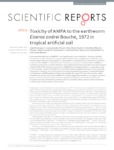Use este identificador para citar ou linkar para este item:
http://www.alice.cnptia.embrapa.br/alice/handle/doc/1059899Registro completo de metadados
| Campo DC | Valor | Idioma |
|---|---|---|
| dc.contributor.author | DOMÍNGUEZ, A. | pt_BR |
| dc.contributor.author | BROWN, G. G. | pt_BR |
| dc.contributor.author | SAUTTER, K. D. | pt_BR |
| dc.contributor.author | OLIVEIRA, C. M. R. de | pt_BR |
| dc.contributor.author | VASCONCELOS, E. C. de | pt_BR |
| dc.contributor.author | NIVA, C. C. | pt_BR |
| dc.contributor.author | BARTZ, M. L. C. | pt_BR |
| dc.contributor.author | BEDANO, J. C. | pt_BR |
| dc.date.accessioned | 2017-01-04T11:11:11Z | pt_BR |
| dc.date.available | 2017-01-04T11:11:11Z | pt_BR |
| dc.date.created | 2017-01-04 | pt_BR |
| dc.date.issued | 2016 | pt_BR |
| dc.identifier.citation | Scientific Reports, London, v. 6, Article 19731, 21 Jan. 2016. 8 p. | pt_BR |
| dc.identifier.uri | http://www.alice.cnptia.embrapa.br/alice/handle/doc/1059899 | pt_BR |
| dc.description | Aminomethylphosphonic acid (AMPA) - one of glyphosate's main metabolites - has been classified as persistent in soils, raising concern regarding the widespread use of glyphosate in agriculture and forestry. Glyphosate may have negative or neutral effects on soil biota, but no information is available on the toxicity of AMPA to soil invertebrates. Therefore our aim was to study the effect of AMPA on mortality and reproduction of the earthworm species Eisenia andrei using standard soil ecotoxicologica I methods (ISO). Field-relevant concentrations of AMPA had no significant effects on mortality in acute or chronic assays. Except at the highest concentration tested, a significant biomass loss was observed compared to controls in the chronic assay. The number of juveniles and cocoons increased with higher concentrations of AMPA applied, but their mean weights decreased. This mass loss indicates higher sensitivity of juveniles than adults to AMPA. Our results suggest that earthworms coming from parents grown in contaminated soils may have reduced growth, limiting their beneficial roles in key soil ecosystem functions. Nevertheless, further research is needed to better understand the mechanisms underlying the sublethal effects observed here. | pt_BR |
| dc.language.iso | eng | eng |
| dc.rights | openAccess | eng |
| dc.subject | Aminomethylphosphonic Acid | pt_BR |
| dc.subject | Ecotoxicological Assessement | pt_BR |
| dc.subject | Herbicide Glyphosate | pt_BR |
| dc.subject | Foetida | pt_BR |
| dc.subject | Solo tropical artificial | pt_BR |
| dc.subject | Earthworm | pt_BR |
| dc.title | Toxicity of AMPA to the earthworm Eisenia andrei Bouché, 1972 in tropical artificial soil. | pt_BR |
| dc.type | Artigo de periódico | pt_BR |
| dc.date.updated | 2019-11-07T11:11:11Z | pt_BR |
| dc.subject.thesagro | Minhoca | pt_BR |
| dc.subject.thesagro | Aminoácido | pt_BR |
| dc.subject.thesagro | Herbicida | pt_BR |
| dc.subject.thesagro | Solo tropical | pt_BR |
| dc.subject.thesagro | Recuperação do solo | pt_BR |
| dc.subject.nalthesaurus | Aminomethylation | pt_BR |
| dc.subject.nalthesaurus | Ecotoxicology | pt_BR |
| dc.subject.nalthesaurus | Herbicides | pt_BR |
| dc.subject.nalthesaurus | Degradation | pt_BR |
| dc.subject.nalthesaurus | Pesticides | pt_BR |
| dc.subject.nalthesaurus | Biomass | pt_BR |
| dc.subject.nalthesaurus | Dynamics | pt_BR |
| riaa.ainfo.id | 1059899 | pt_BR |
| riaa.ainfo.lastupdate | 2019-11-07 -02:00:00 | pt_BR |
| dc.identifier.doi | 10.1038/srep19731 | pt_BR |
| dc.contributor.institution | ANAHÍ DOMÍNGUEZ, CONICET; GEORGE GARDNER BROWN, CNPF; KLAUS DIETER SAUTTER, UNIVERSIDADE POSITIVO; CINTIA MARA RIBAS DE OLIVEIRA, UNIVERSIDADE POSITIVO; ELIANE CARVALHO DE VASCONCELOS, UNIVERSIDADE POSITIVO; CINTIA CARLA NIVA, CPAC; MARIE LUISE CAROLINA BARTZ, UNIVERSIDADE POSITIVO; JOSÉ CAMILO BEDANO, CONICET. | pt_BR |
| Aparece nas coleções: | Artigo em periódico indexado (CNPF)  | |
Arquivos associados a este item:
| Arquivo | Descrição | Tamanho | Formato | |
|---|---|---|---|---|
| 2016G.BrownSRToxicityofAMPA.pdf | 557.88 kB | Adobe PDF |  Visualizar/Abrir |









